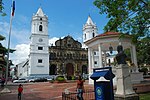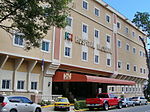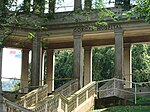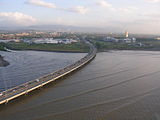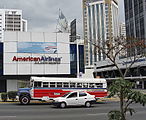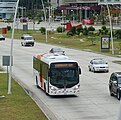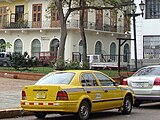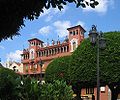Panama City
Panama City | |
|---|---|
City | |
| Panamá | |
 Skyline of Panama City as of 2012 | |
| Country | Panamá |
| Province | Panamá |
| District | Panamá |
| Foundation | August 15, 1519 |
| Founded by | Pedro Arias de Ávila |
| Government | |
| • Mayor | Roxana Méndez |
| Area | |
| • City | 275 km2 (106 sq mi) |
| • Metro | 2,560.8 km2 (988.7 sq mi) |
| Elevation | 2 m (7 ft) |
| Population (2010) | |
| • City | 880,691 |
| • Density | 2,750/km2 (7,656/sq mi) |
| • Metro | 1,272,672 |
| HDI (2007) | 0.780 – high[1] |
| Website | www.municipio.gob.pa |
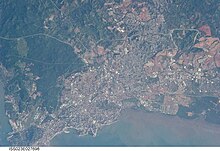
Panama City (Spanish: Ciudad de Panamá) is the capital and largest city of the Republic of Panama.[2][3] It has a population of 880,691, with a total metro population of 1,272,672,[4] and is located at the Pacific entrance of the Panama Canal, in the province of Panama. The city is the political and administrative center of the country, as well as a hub for international banking and commerce.[5] It is considered a "beta" world city, one of three Central American cities listed in this category.[6]
Panama City has an average GDP per capita of $11,700.[7] It has a dense skyline of mostly high-rise buildings, and it is surrounded by a large belt of tropical rainforest. Panama's Tocumen International Airport, the largest and busiest airport in Central America, offers daily flights to major international destinations. Panama City was chosen as the 2003 American Capital of Culture jointly with Curitiba, Brazil. It is among the top five places for retirement in the world, according to International Living magazine.
Panama City was founded on August 15, 1519, by Spanish conquistador Pedro Arias Dávila. The city was the starting point for expeditions that conquered the Inca Empire in Peru. It was a stopover point on one of the most important trade routes in the history of the American continent, leading to the fairs of Nombre de Dios and Portobelo, through which passed most of the gold and silver that Spain took from the Americas.
On January 28, 1671, the city was destroyed by a fire when pirate Henry Morgan sacked and set fire to it. The city was formally reestablished two years later on January 21, 1673, in a peninsula located 8 km from the original settlement. The site of the previously devastated city is still in ruins and is now a popular tourist attraction known as Panama Viejo.
History
Geography
Panama is located between the Pacific Ocean and tropical rain forest. The Parque Natural Metropolitano (Metropolitan Nature Park), stretching from Panama City along the Panama Canal, has unique bird species and other animals, such as tapir, puma, and caimans. At the Pacific entrance of the canal is the Centro de Exhibiciones Marinas (Marine Exhibitions Center), a research center for those interested in tropical marine life and ecology, managed by the Smithsonian Tropical Research Institute.
Tropical forests around Panama are vital for the functioning of the Panama Canal, providing it with the water required for its operation; the canal is thus a rare example of a vast engineering project in the middle of a forest that helped to preserve that forest. Due to the canal's importance to the Panamanian economy, tropical forests around the canal have been kept in an almost pristine state. Along the western side of the canal is the Parque Nacional Soberania (Sovereignty National Park), which includes the Summit botanical gardens and a zoo. The best known trail in this national park is Pipeline Road, popular among birdwatchers.[8]
Nearly 500 rivers lace Panama's rugged landscape. Most are unnavigable; many originate as swift highland streams, meander in valleys, and form coastal deltas. However, the Río Chepo and the Río Chagres, both within the boundaries of the city, work as sources of hydroelectric power.
The Río Chagres is one of the longest and most vital of the approximately 150 rivers that flow into the Caribbean. Part of this river was dammed to create Gatun Lake, which forms a major part of the transit route between the locks near each end of the canal. Both Gatun Lake and Madden Lake (also filled with water from the Río Chagres) provide hydroelectricity to the former Canal Zone area. The Río Chepo, another major source of hydroelectric power, is one of the more than 300 rivers emptying into the Pacific.
Climate
Under the Köppen climate classification, Panama City has a tropical wet and dry climate. It sees 1900 mm of precipitation annually. The wet season spans from May through December, and the dry season spans from January through April. Temperatures remain constant throughout the year, averaging around 30 °C (86 °F).
| Climate data for Panama City (1971–2000) | |||||||||||||
|---|---|---|---|---|---|---|---|---|---|---|---|---|---|
| Month | Jan | Feb | Mar | Apr | May | Jun | Jul | Aug | Sep | Oct | Nov | Dec | Year |
| Mean daily maximum °C (°F) | 33.4 (92.1) |
34.2 (93.6) |
34.8 (94.6) |
35.4 (95.7) |
34.5 (94.1) |
33.8 (92.8) |
33.9 (93.0) |
33.9 (93.0) |
32.9 (91.2) |
32.6 (90.7) |
32.9 (91.2) |
33.3 (91.9) |
33.8 (92.8) |
| Mean daily minimum °C (°F) | 18.5 (65.3) |
18.4 (65.1) |
18.4 (65.1) |
19.5 (67.1) |
21.1 (70.0) |
21.3 (70.3) |
21.0 (69.8) |
20.9 (69.6) |
21.0 (69.8) |
20.8 (69.4) |
20.3 (68.5) |
19.2 (66.6) |
20.0 (68.0) |
| Average rainfall mm (inches) | 29.3 (1.15) |
10.1 (0.40) |
13.1 (0.52) |
64.7 (2.55) |
225.1 (8.86) |
235.0 (9.25) |
168.5 (6.63) |
219.9 (8.66) |
253.9 (10.00) |
330.7 (13.02) |
252.3 (9.93) |
104.6 (4.12) |
1,907.2 (75.09) |
| Average rainy days (≥ 0.1 mm) | 2.9 | 1.3 | 1.4 | 4.9 | 15.0 | 16.0 | 14.0 | 15.0 | 17.0 | 20.0 | 16.0 | 7.5 | 131.0 |
| Mean monthly sunshine hours | 228.9 | 245.2 | 183.9 | 173.1 | 108.5 | 116.3 | 106.1 | 118.1 | 99.2 | 103.9 | 139.8 | 120.5 | 1,743.5 |
| Source 1: World Meteorological Organization[9] | |||||||||||||
| Source 2: ETESA (sunshine data recorded at Albrook Field)[10] | |||||||||||||
Cityscape

Architecture
Panama's old quarter features many architectural styles, from Spanish colonial buildings to French and Antillean townhouses built during the construction of the Panama Canal.[11] The more modern areas of the city have many high-rise buildings, which together form a very dense skyline. There are currently more than 110 high-rise projects under construction, with 127 already built.[12] The city holds the 40th place in the world by high-rise buildings count.[13]
The Centennial Bridge that crosses the Panama Canal earned the American Segmental Bridge Institute prize of excellence, along with seven other bridges in the Americas.[14]
Neighborhoods
The city is located in Panama District, although its metropolitan area also includes some populated areas on the opposite side of the Panama Canal. As in the rest of the country, the city is divided into corregimientos, in which there are many smaller boroughs. The old quarter, known as the Casco Viejo, is located in the corregimiento of San Felipe. San Felipe and twelve other corregimientos form the urban centre of the city, including Santa Ana, El Chorrillo, Calidonia, Curundú, Ancón, Bella Vista, San Francisco, Parque Lefevre, and Río Abajo.
Economy

As the economic and financial center of the country, Panama City's economy is service-based, heavily weighted toward banking, commerce, and tourism.[15] The economy depends significantly on trade and shipping activities associated with the Panama Canal and port facilities located in Balboa. The city has benefited from significant economic growth in recent years, mainly due to the ongoing expansion of the Panama Canal, an increase in real estate investment, and a relatively stable banking sector.[16] There are around eighty banks in the city, at least fifteen of which are national.
Panama City is responsible for the production of approximately 55% of the country's GDP. This is because most Panamanian businesses and premises are located in the city and its metro area.[17] It is a stopover for other destinations in the country, as well as a transit point and tourist destination in itself.
Tourism is one of the most important economic activities in terms of revenue generation. The city's hotel occupancy rate has always been relatively high, reaching the second highest for any city outside the United States in 2008, after Perth, Australia, and followed by Dubai.[18] However, hotel occupancy rates have dropped since 2009, probably due to the opening of many new luxury hotels.[19] Several international hotel chains, such as Le Méridien, Radisson, and RIU, have opened or plan to open new hotels in the city,[20] along with those previously operating under Marriott, Sheraton, InterContinental, and other foreign and local brands. Also, the Trump Organization is currently building the Trump Ocean Club, its first investment in Latin America,[21] and Hilton Worldwide recently opened its first Garden Inn Panama, at Eusebio A. Morales Avenue and 49A Street West, and plans to open The Panamera, the second Waldorf Astoria Hotel in Latin America.[22]
Demographics
The city proper has around 880,691 inhabitants in 23 boroughs.[23] The inhabitants of Panama City are commonly referred to as capitalinos and include large numbers of Afro-Panamanians, mestizos, and mulattos, with notable white and Asian minorities.[24]
Culture
World Heritage Sites
| UNESCO World Heritage Site | |
|---|---|
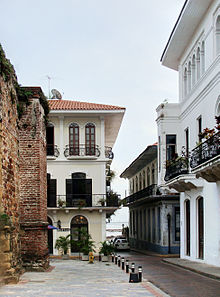 | |
| Criteria | Touristic, Cultural and Global: II, IV, VI |
| Reference | 790 |
| Inscription | 1997 (21st Session) |
| Extensions | 2003 |
Panamá Viejo
Panamá Viejo ("Old Panama")[25] is the name used for the architectural vestiges of the Monumental Historic Complex of the first Spanish city founded on the Pacific coast of the Americas by Pedro Arias de Avila on August 15, 1519. This city was the starting point for the expeditions that conquered the Inca Empire in Peru in 1532. It was a stopover point on one of the most important trade routes in the history of the American continent, leading to the famous fairs of Nombre de Dios and Portobelo, where most of the gold and silver that Spain took from the Americas passed through.[26]
The committee decided to inscribe this property on the basis of cultural criteria (ii), (iv), and (vi), considering that Panama was the first European settlement on the Pacific coast of the Americas, in 1519, and that the Historic District preserves intact a street pattern along with a substantial number of early domestic buildings, which are testimony to the nature of this early settlement.[26]
Casco Viejo or Casco Antiguo
Built and settled in 1671 after the destruction of Panama Viejo by the privateer Henry Morgan, the historic district of Panama City (known as Casco Viejo, Casco Antiguo, or San Felipe) was conceived as a walled city to protect its settlers against future pirate attacks. It was designated a World Heritage Site by UNESCO in 2003.[27]
Casco Antiguo displays a mix of architectural styles that reflect the country's cultural diversity: Caribbean, Republican, art deco, French, and colonial architecture mix in a site comprising around 800 buildings. Most of Panama City's main monuments are located in Casco Antiguo, including the Salón Bolivar, the National Theater (founded in 1908), Las Bóvedas, and Plaza de Francia. There are also many Catholic buildings, such as the Metropolitan Cathedral, the La Merced Church, and the St. Philip Neri Church. The distinctive golden altar at St. Joseph Church was one of the few items saved from Panama Viejo during the 1671 pirate siege. It was buried in mud during the siege and then secretly transported to its present location.
- The Future of Casco Viejo
Currently undergoing redevelopment, the old quarter has become one of the city's main tourist attractions, second only to the Panama Canal. Both government and private sectors are working on its restoration.[28] However, a construction project proposed by President Ricardo Martinelli has recently proven controversial. Named "Cinta Costera 3", this project includes the construction of a maritime highway viaduct around the Casco Antiguo.[29] Proponents claim the road will ease traffic congestion in the city while "[causing] a positive dialog between [the] highly contrasting areas of the city."[29] Opponents of the $776.9-million[30] project say the road will ruin the view of the horizon from the Casco Antiguo and that there are alternatives to the viaduct (such as a tunnel) that could protect the "integrity" of the place.[31] Much of the controversy surrounding the project involves the possibility that Casco Viejo will lose its World Heritage status. On June 28, 2012, UNESCO decided that Casco Viejo will not be put on the List of World Heritage Sites in Danger, while affirming the importance that further studies be conducted to demonstrate the project will not be culturally detrimental to Casco Viejo and that the viaduct is the "most viable option".[32]
Literature
According to Professor Rodrigo Miró, the first story about Panama was written by Gonzalo Fernández de Oviedo y Valdés and published as part of the Historia General y Natural de Las Indias in 1535. Some poets and novelists born in Panamá city are Manuel María Ayala (1785–1824), Amelia Denis de Icaza (1836–1911), Darío Herrera (1870–1914), Ricardo Miró (1883–1940), Gaspar Octavio Hernández (1893–1918), Demetrio Korsi (1899–1957), Ricardo Bermúdez (1914–2000), Joaquín Beleño (1922–88), Ernesto Endara (1932–), Diana Morán (1932–87), José Córdova (1937–), Pedro Rivera (1939–), Moravia Ochoa López (1941–), Roberto Fernández Iglesias (1941–), Jarl Ricardo Babot (1946–), Giovanna Benedetti (1949–), Manuel Orestes Nieto (1951–), Moisés Pascual (1955–), Héctor Miguel Collado (1960–), David Robinson Orobio (1960–), Katia Chiari (1969–), Carlos Oriel Wynter Melo (1971–), José Luis Rodríguez Pittí (1971–), and Sofía Santim (1982–).[33]
Tourism

The city has numerous tourist attractions. Particularly interesting for tourists are sites located in the old quarter, including:
- Las Bóvedas ("The Vaults"), a waterfront promenade jutting out into the Pacific;
- The National Institute of Culture Building and the French embassy across from it;
- The Cathedral at Plaza de la Catedral;
- Teatro Nacional, an intimate performance center with outstanding natural acoustics and seating for about 800 guests;
- Museo del Canal Interoceánico (Interoceanic Canal Museum); and
- Palacio de las Garzas (Heron's Palace), the official name of the presidential palace, named for the numerous herons that inhabit the building.
The area immediately east of the Pacific entrance of the canal, known as the Amador Causeway, is being developed as a tourist center and nightlife destination. The Smithsonian Tropical Research Institute operates a station and a small museum open to the public at Culebra Point on the island of Naos. A new museum, the Museum of Biodiversity or BioMuseo, is under construction on the causeway. It was designed by the American architect Frank Gehry, famous for the Guggenheim Museum Bilbao and the Disney Concert Hall in Los Angeles.[34] Just outside the city limits is the Parque Municipal Summit.
-
Plaza de la Independencia
-
Archway and classic calicanto wall in a traditional house
-
Compañía de Jesús, the ruins of an ancient convent of the Society of Jesus
Sports
Throughout the 20th century, Panama City has excelled in boxing, baseball, basketball, and soccer. These sports have produced famous athletes such as Roberto Durán, Rommel Fernández, Rolando Blackman, Mariano Rivera, and Rod Carew. Today, these sports have clubs and associations that manage their development in the city. Panama Metro is the city's baseball team. There are boxing training centers in different gyms throughout the city's neighborhoods. There are also many football clubs, such as:
The city has four professional teams in the country's second level league, Liga Nacional de Ascenso:
There are two main stadiums in Panama City, the National Stadium (also known as Rod Carew Stadium) and the Rommel Fernández Stadium, with capacities of 27,000 and 32,000 respectively. Additionally, the Roberto Durán gymnasium has a capacity of 18,000.
-
Rommel Fernandez Stadium
-
Rod Carew National Stadium
-
Roberto Duran Arena
Education
The city has both public and private schools. Most of the private schools are at least bilingual. Higher education is headed by the two major public universities: the University of Panama and the Technological University of Panama. There are private universities, such as the Universidad Católica Santa María La Antigua, the Distance and Open University of Panama (UNADP), and the Universidad del Istmo. The University of Louisville runs a sister campus in the city,[35] while Florida State University operates a broad curriculum program[36] in an academic and technological park known as Ciudad del Saber.
Healthcare
Panama City is home to at least 14 hospitals and an extensive network of public and private clinics, including the Hospital Santo Tomás, Hospital del Niño, Complejo Hospitalario Arnulfo Arias Madrid, Centro Médico Paitilla, Hospital Nacional, Clinica Hospital San Fernando, and Hospital Punta Pacifica.
About 45% of the country's physicians are located in Panama City.[37] Most Panamanian doctors receive their degrees from local universities, although some receive additional U.S. or foreign training. Standards at top hospitals compare to those in the United States. Panama City is a common destination for medical tourism.[38]
-
Hospital Santo Tomás, the largest public hospital in the country
-
Hospital Nacional, a full-service private hospital
-
Instituto Oncológico Nacional, at former Gorgas Hospital
Transportation
Panama's international airport, Tocumen International Airport, has two runways and is located on the eastern outskirts of the city's metropolitan area. There are direct flights between Tocumen and the United States, some European cities, and all major cities in the Caribbean, Central America, and South America, like São Paulo, Rio de Janeiro, Santiago de Chile, Buenos Aires, and Lima. Panama City has a regional airport, Marcos A. Gelabert, located in an area once occupied by Albrook Air Force Base. Marcos A. Gelabert Airport is the main hub for regional flights within Panama and the Pearl Islands in the Pacific and Bocas del Toro islands in the Caribbean.
There are frequent traffic jams in Panama City due to the high levels of private transport ownership per mile of traffic lane. In an attempt to curb traffic jams, President Ricardo Martinelli has brought forward a citywide metro system, initially 14 km long, stretching across the city.[39] This new metro system, along with the Metrobus,[40] will replace the current public transportation system.
The bus terminal located in Ancon offers buses in and out of the city. Bus service is one of the most widely used forms of transportation in Panama. The terminal receives thousands of passengers daily from locations like David, Chiriqui, and the central provinces of Herrera and Los Santos. The terminal also receives international passengers from Central America via the Pan-American Highway.
Panama City offers transportation services through yellow taxis. Taxis do not use a meter to measure fares, instead using a zone system for fares that is published by the Autoridad de Transito y Transporte Terrestre, Panama's transit authority. Major vehicle rental companies are located at the airports.
Although Panama City is modernizing its public transportation system, it is still possible to see a form of public transportation consisting of colorfully painted buses, colloquially known as diablos rojos. A diablo rojo is usually painted with bright colors, usually depicting famous actors, politicians, or singers. It is popular for bus drivers to customize the interior and exterior of their diablo rojo.
-
The puente marino ("marine bridge"), Corredor Sur ("South Corridor")
-
Tocumen International Airport, Panama's international airport
-
Discontinued public buses
-
Metrobus, the new public transport system, to feed the new Panama Metro
-
Taxi in Panama City
International relations
Twin towns – Sister cities
Panama City is twinned with:[41][42]
|
Gallery
-
The belltower of the San Francisco de Asis Church.
-
Plaza Bolivar in Casco Viejo
-
Ruins of the Old Panama
-
Santa Ana Park
-
Causeway connecting Naos, Perico, and Flamenco Islands to the mainland
-
The Bridge of the Americas, at the Pacific entrance to the Panama Canal
-
Governmental office and residence of the president of Panama
-
Plaza de Francia, a square in honor of the workers and French engineers who participated in the construction of the Panama Canal.
-
Skyline seen from Casco Viejo
-
The former Balboa Avenue
-
Panama skycrapers
-
Panama Bay
-
View of part of the metropolitan area of Panama
See also
References
Footnotes
- ^ "Informe de Desarrollo Humano en Panamá" (in Spanish). 2007. Retrieved 7 September 2010.
- ^ Real Academia de la Lengua Española (October 2005). "Diccionario panhispánico de dudas. Apéndice 5: Lista de países y capitales, con sus gentilicios" (in Spanish). Retrieved 20 March 2011.
- ^ Real Academia Española y Asociación de Academias de la Lengua Española, «Lista de países y capitales, con sus gentilicios», Ortografía de la lengua española, Madrid, Espasa Panamá.1 País de América., p. 726, ISBN 978-84-670-3426-4,
GENT. panameño -ña. CAP. Panamá.
Panamá.2 Capital de Panamá. - ^ "Censos Nacionales 2010" (in Spanish). Retrieved 2011-02-11.
- ^ "Investing in Panama". BussinesPanama.com. Retrieved 2010-12-16.
- ^ www.lboro.ac.uk The World According to GaWC 2008 – Retrieved on 2010-10-10
- ^ "Panama GDP - per capita (PPP) - Economy". Indexmundi.com. 2010-02-19. Retrieved 2010-06-26.
- ^ "Canopy Tower, a famous birdwatchers hotel". Canopytower.com. Retrieved 2010-06-26.
- ^ "World Weather Information Service - Panama City". World Meteorological Organization. Retrieved April 10, 2013.
- ^ "Datos Históricos : Estación Albrook Field" (in Spanish). Empresa de Transmision Electrica S.A. Retrieved April 10, 2013.
- ^ "In Panama City's Old Quarter, a Rebirth Takes Place". Boston Globe. 2007-01-22. Retrieved 2011-02-11.
- ^ "Skyscraper page Panama City". Skyscraperpage.com. Retrieved 2010-06-26.
- ^ "Skyscraper page Cities List". Skyscraperpage.com. Retrieved 2010-06-26.
- ^ "La Prensa Newspaper". Mensual.prensa.com. Retrieved 2010-06-26.
- ^ "Panama Useful Facts". Retrieved 2011-02-17.
- ^ "Panama economy grew 2.4 percent in 2009". Reuters. 2010-03-02. Retrieved 2011-02-17.
- ^ "Municipio de Panamá". Municipio.gob.pa. Retrieved 2010-06-26.
- ^ "Panama City Has The Second Highest Hotel Occupancy Outside Of The United States". 2008-05-06. Retrieved 2011-02-17.
- ^ "Hotel occupancy rates see sharp drop". 2009-10-21. Retrieved 2011-02-17.
- ^ "Twenty-two Hotels are Under Construction in Panama". Retrieved 2011-02-17.
- ^ "Donald J. Trump Launches His First Luxury Development in Panama". 2006-04-26. Retrieved 2011-02-17.
- ^ "Hilton Worldwide announces development of first Waldorf Astoria Hotel in Latin America". 2010-08-24. Retrieved 2011-02-17.
- ^ "Panama City Hall (Spanish"[dead link]
- ^ [1]
- ^ "Panama Viejo". Patronato Panama Viejo. Retrieved July 18, 2010.
- ^ a b "UNESCO Official Site". Whc.unesco.org. 1997-12-07. Retrieved 2010-06-26.
- ^ http://whc.unesco.org/en/list/790/
- ^ "Panama Casco Viejo Blog – Panama News: World Bank invests in Cultural Industries for Casco Antiguo". Arcoproperties.com. 2008-09-11. Retrieved 2010-06-26.
- ^ a b "Darién mira la discusión en San Petersburgo so you don't have to". Retrieved 4 July 2012.
- ^ González Jiménez, Roberto. "Odebrecht gana licitación para tercera fase de cinta costera". Prensa.com. Retrieved 4 July 2012.
- ^ "Say NO to a road around Casco Viejo". Retrieved 4 July 2012.
- ^ "Gobierno debe presentar estudios de opción más viable para cinta costera 3". Prensa.com. Retrieved 4 July 2012.
- ^ Panamanian literature
- ^ Panama:Bridge of Life|Biodiversity Museum[dead link]
- ^ "Channing Slate's Homepage". Web.archive.org. 2008-01-08. Retrieved 2009-08-05.
- ^ "FSU-Panama Homepage". Retrieved 2011-02-17.
- ^ "Panama City Hall information on education and healthcare" (in Spanish). Retrieved 2011-04-23.
- ^ "Medical Tourism in Panama". Health-Tourism.com. Retrieved 2011-04-23.
- ^ "El Metro de Panamá". Secretaría del Metro. Retrieved July 18, 2010.
- ^ "Metrobus Panama". Metrobus Panama. Retrieved July 18, 2010.
- ^ a b c d List of sister cities in Panama from Sister Cities International
- ^ a b c Panama - Fort Lauderdale and Miami on Sister Cities.com
- ^ "Sister Cities, Public Relations". Guadalajara municipal government. Archived from the original on March 2, 2012. Retrieved March 12, 2013.
- ^ Sister city list (.DOC)
- ^ "Taipei City Council". Retrieved 2007-02-24.
- ^ "Panama City and Tel Aviv Sign Agreement to Become Sister Cities". Caribbean Journal. Retrieved 2013-06-25.
Bibliography
- Mellander, Gustavo A.; Nelly Maldonado Mellander (1999). Charles Edward Magoon: The Panama Years. Río Piedras, Puerto Rico: Editorial Plaza Mayor. ISBN 1-56328-155-4. OCLC 42970390.
- Mellander, Gustavo A. (1971). The United States in Panamanian Politics: The Intriguing Formative Years. Danville, Ill.: Interstate Publishers. OCLC 138568.






